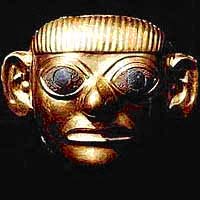| Edited by HENRY REED, Ph.D. |
June 10, 2008
|

Looking at Reincarnation
By Ralph DavisAtlantic UniversityWe could examine the subject of reincarnation from many different angles. Many books have been written about it; many more will be. Just as popular interest in—and acceptance of—reincarnation has mushroomed in the last 40 years, our knowledge of the subject has grown exponentially. Along with this new knowledge have come new ways of applying it to healing. By comparison, the means at Edgar Cayce’s disposal were quite meager. He was able to retrieve large amounts of information on behalf of his clients, and give them guidance on how to use their innate abilities in this life. But the idea that people can remember their own past lives; relive painful experiences from these lives, up to and including their deaths; achieve a cathartic release of the emotions, and thereby achieve lasting healing in their current lives, is quite recent. I intend to restrict myself here to a few aspects of reincarnation: · Past-life exploration versus past-life therapy · Are past-life memories individual? Or do we share them? · How do we apply what we learn to our current lives? To make my discussion more concrete, I will present a past-life memory that came to me in a self-hypnosis session. Besides a few Internet references, I’m confining my sources to two books by pioneers in the field: Roger Woolger’s Other Lives, Other Selves and Brian Weiss’s Through Time into Healing. Both Woolger and Weiss are professional therapists, Woolger as a clinical psychologist and Weiss as a psychiatrist. Both of these books are richly detailed with case studies from their clinical practices. Both men stumbled onto past-life therapy. Weiss asked one of his patients to go back to the source of a problem she was having, thinking she would bring up a childhood memory. Instead, she gave him a chronicle of a long-ago lifetime. Woolger agreed to undergo a past-life regression, though he was highly skeptical of the whole notion. To his surprise, he told a story he couldn’t possibly have made up, finding himself in the Middle Ages persecuting heretics on behalf of the Inquisition. Fortunately, both men recognized the value of their discovery. Quoting Weiss: “I realized that past life therapy offered a rapid method of treating psychiatric symptoms, symptoms that had previously taken many months or years of costly therapy to alleviate. Here was a much more direct way to heal pain and fear.” (Through Time into Healing, p. 22) Most of the excerpts I quote here are from Woolger’s book, for the simple reason that he spends more time pondering the cosmological implications of his discoveries. Past-Life Therapy vs. Past-Life ExplorationPast-life therapy is not the same as past-life exploration. Past-life exploration is the process of retrieving ancient memories from the subconscious. Past-life therapy goes beyond this to have you relive the memories and release the painful emotions associated with them. Hypnosis is usually the preferred vehicle for both, though dreams can also make a large contribution. Past-life exploration can reveal an amazing amount of information about previous incarnations—information that, in many cases, you will be able to verify through subsequent historical research. But only past-life therapy can free you from difficult past-life emotions that are still affecting you in this life. You can do past-life exploration on your own with self-hypnosis. Past-life therapy, on the other hand, requires a professional therapist. For one thing, hypnosis with someone else guiding you (“heterohypnosis”) will take you deeper than self-hypnosis (Edgar Cayce being an obvious exception), although consistent practice of self-hypnosis does help you reach deeper trance states in heterohypnosis. But past-life exploration under self-hypnosis can give you a glimpse of the incredible breadth of human experience contained in the Akashic records, or the Collective Unconscious, or whatever term you prefer. You don’t have to believe in reincarnation to have vivid experiences. As Roger Woolger puts it, “all you have to do is believe in the power of the unconscious mind” (Other Lives, Other Selves, p. 82). Nor does past-life exploration require a deep trance state or a lot of practice. Using Henry Bolduc’s “Blue Mist” script, published in his book The Journey Within (p. 286), I began seeing images of other lives right away. His approach is very effective. After taking you back to the Blue Mist—his name for a nebulous between-lives state—he has you imagine yourself reincarnating out of the Blue Mist, then asks you to look down at your feet and say what you’re wearing. On my first try, I saw bare feet, and a look around showed me that I was a caveman. Then even before my second session, I started seeing images of Roman sandals—it was as if a presence knew I was searching around in my subconscious and wanted to make sure I didn’t miss him. Sure enough, once I lay down with the “Blue Mist” script, I saw a Roman soldier. (I’ll talk more about him later.) Past-life Memories: Individual or Collective?When most of us talk about past lives, we take it for granted that we each have our own set of lives through which we have built up our karmic profiles. We all have our own file in the Akashic records, though people with heightened perception, like Edgar Cayce, can read other people’s files. But is this an incorrect, or at the very least an incomplete, model? Once we go beyond the boundaries of our separate egos, we enter realms where consciousness may well be shared. Carl Jung’s term “Collective Unconscious” is predicated on this assumption. If the unconscious really is collective, and the unconscious is the seat of past-life memories, then is it possible that all of us have the same pool of past lives available to us? Here’s what Roger Woolger says about this: “[One] position on past lives commonly proposed is what I call the Great Memory position. By this I mean the belief that we all have access, in dreams, meditation, or hypnosis, to a stratum of the unconscious mind which is universal and consists of not just our own forgotten experiences or fantasies. This position holds that we all have the capacity, rightly prepared, to dip into the vast collective memory bank of mankind. This universal memory has been called variously the Akashic record, the collective unconscious (Jung), or simply Great Mind.” (Other Lives, Other Selves, p. 41) More than one of Woolger’s clients has told him of a past life as Joan of Arc (p. 65). (In fact, she is a common reincarnational memory for many women.) Woolger offers a cautious explanation: that each of these women fused her own unconscious memories with conscious knowledge she had of Joan of Arc. But isn’t it also possible that both of them gained access to Joan of Arc’s Akashic record while under hypnosis, extracting from it the portion that was relevant to their life? Woolger does not shy away from the logical implication of this: that it does not require reincarnation at all. If we all share a single collective unconscious, and with the right guidance and discipline can tap into it, then we should be able to view any life from any period of time, without having lived it. He even takes this idea one step further by presenting what he calls the “Integral-Mystical” perspective on reincarnation: …all past lives are present to the Self and all roles are known as aspects of the Self. …
From such a
perspective, there is no reincarnation because the individual soul that
is said to be reborn has no separate reality except as one of the billions of
sparks of the Great Mind. … “Verily,” said the great Indian sage Sankara, “there
is no transmigrant but the Lord,” by which he meant the atman, the Self
at the heart of all beings and of all Being.
What does this do to the notion of karma? Doesn’t it throw it right out the window? Indeed, says Woolger, that’s exactly what Buddhism does, at least with karma at the individual level: ‘In Buddhism it is strictly incorrect to speak of “my karma” or “your karma,” since notions of “mine” and “yours” belong to the illusory sense of individual self which we call ego. In the end there is only karma, the psychic inheritance of the accumulation of mankind’s thoughts and actions, as passed through the great cycle of rebirth. My karma is your karma and yours is mine.” (Other Lives, Other Selves, p. 77) Ultimately, of course, these are unanswerable questions: none of us will ever be able to prove that one view or another is the right one. Woolger does admit that he leans toward the idea that past-life memories, and therefore karma, are individual. Brian Weiss agrees. So does Edgar Cayce: he speaks of “entities” that live many lives, and it is clear in his readings that there are many such entities. As you will see in the next section, one particular memory that came to me in a self-hypnosis session made this question very personal. The life I “remembered,” or whatever the verb is, was not exemplary. Case Study: Governor of SyriaI had this memory using Henry Bolduc’s “Blue Mist” script in self-hypnosis. As I came out of the Blue Mist, I saw myself wearing Roman sandals. In fact, as I mentioned earlier, this image had been following me around for a couple of days before I actually lay down for the session. As my inner gaze moved up my body, I perceived that I was wearing the armor and plumed headdress of a Roman soldier, and I was riding around in a Roman military chariot. As the story unfolded, I saw myself as a general leading Roman armies in a successful campaign somewhere, I didn’t know where. I was rewarded for my victories by being appointed governor of Syria. Once in this position, I became very adept at manipulating the local ruling elites. Though I was quite willing to use violence and intimidation to enforce my will, most of the time I didn’t have to. I learned quickly who would be willing to betray their country for a large enough bribe. I became quite skillful at playing them off against each other, letting them outbid one another to offer me the most treasonous services. When the script asked me to picture my death, I got the sense that I was killed doing the only thing I really loved—killing other people in the heat of combat. I didn’t see or relive the death experience itself. The details of this story are quite sketchy, as you can see. Out of curiosity, I googled “Roman governors of Syria.” This led me to a Wikipedia article listing five men who were Roman governors of Syria (http://en.wikipedia.org/wiki/Category:Roman_governors_of_Syria): · Mucianus, governor during the Jewish revolt in 66 CE. No events of his life match my governor. · Quirinius, governor from c. 5 CE until 12 CE. He ordered the census of Judea that has been immortalized in the New Testament accounts of the birth of Jesus. However, he died a natural death, and does not resemble my governor. · Gaius Ummidius Durmius Quadratus, governor from 50 CE until 60 CE. Not a candidate—he too died a natural death. · Lucius Vitellius, governor in 35 CE (I don’t know for how long). He died of paralysis in 51 CE. · Publius Quinctilius Varus, known as Varus, governor in the years around the beginning of the first millennium. Let’s take a closer look at him. He was a friend of the Emperor Augustus, and served as consul along with Tiberius in 13 BCE. In 8 BCE, he was made governor of the province of Africa (modern-day Tunisia), perhaps through Tiberius’s influence. An article by Jona Lendering, published at http://www.livius.org/q/quinctilius/varus.html, states that: “The governorship of Africa was a very prestigious position: it was one of the provinces ruled by the Senate, and the only one with a legion, III Augusta. (All other garrisoned provinces were ruled by the emperor.) Varus ruled this part of the Roman world in 8-7 BCE. Although we do not know about any military interventions, he must have shown that he was a capable general, because he was reappointed as governor of Syria, where he had to command one sixth of the Roman army. It is possible that Augustus and Tiberius had always wanted to make their relative and friend commander of the Syrian army; in that case, the governorship of Africa was a mere traineeship.” Let’s follow him to Syria. The Roman historian Gaius Velleus Paterculus, in his Roman History, says of him: How far he was from despising money, Syria, of which he had been governor, afforded proof; for, going a poor man into that rich province, he became a rich man, and left it a poor province. (Quoted at http://www.ancient-times.com/articles/varus/varus.html) Nor was greed his only vice. Here’s what his Wikipedia page has to say about an incident that occurred during his tenure in Syria: The Jewish historian Josephus mentions the swift action of Varus against a messianic revolt in Judaea after the death of Rome's client king Herod the Great in 4 BC. After occupying Jerusalem, he crucified 2,000 Jewish rebels, and may have thus been one of the prime objects of popular anti-Roman sentiment in Judaea. (See http://en.wikipedia.org/wiki/Publius_Quinctilius_Varus) When he came back from Syria, Augustus sent him to Germany to advance Rome’s imperial agenda there: “When Augustus, intending to expand his dominion of Germania to the Elbe River, appointed Varus governor to Germania, Varus continued his exploitation of local populations.” (Quoted at http://ancienthistory.about.com/library/bl/bl_varusteutoberg.htm) Nevertheless, he was about to become famous, or rather infamous. In 9 CE, he foolishly led his three legions into a trap in the Teutoberg Forest, where the German warriors they were pursuing completely annihilated them. It is generally accepted that Varus committed suicide, though no one really knows: there were no Roman survivors. The Germans did extend one small courtesy: they cut off Varus’s head and sent it back to Augustus in Rome. Applying What You LearnOne of Edgar Cayce’s key points about psychic self-exploration is the importance of applying what you learn to your present life. Woolger calls this process “reintegration” and “rebalancing.” Brian Weiss also emphasizes how important it is, and states that this part of past-life therapy is what demands the most skill of the therapist. As Weiss and Woolger explain it, in past-life therapy you confront aspects of yourself that can be very painful, or not very attractive. You may remember a terrible death, or see the life of someone who killed thousands of people. You heal by accepting these selves as manifestations of yourself and releasing feelings left over from the previous life. For me to better understand the appearance of Varus in my past-life regression, my first step will be to schedule some sessions with a skilled therapist. In my self-hypnosis, I didn’t reexperience any of the emotions involved in that life. In fact, the session itself didn’t tell me very much; most of the information came from my subsequent research. Did I really live a life as someone who ordered the mass crucifixion of 2,000 people? If so, what influence does that life have on my current life? Why did my subconscious serve up an image of this man right now? I have no idea how to answer these questions. When answers do come, they have to well up from my soul spontaneously after in-depth treatment and catharsis. Intellectual understandings don’t produce healing. Final ThoughtsPast-life regression is not something you undertake so you have something to talk about at cocktail parties: “Hey, man, guess who I was…I was Varus, man…know who Varus was? He was a bad dude, man…” Woolger states it as follows: “…today [reincarnation] all too easily becomes yet another piece of consumer-ready spiritual psychology which does nothing but feed the insatiable narcissism of our rootless culture.“ (Other Lives, Other Selves, p. 74) Didn’t Jack Kerouac (one of our most entrenched narcissists) claim to have been Napoleon? Well, I suppose somebody had to have been Napoleon. But there have been a lot more nobodies in human history than Napoleons. Quoting Woolger again: “…it is not romance that most characterizes the majority of past lives I meet in therapy, but bitter and unrelenting realism.” (Other Lives, Other Selves, p. 39) Woolger cites the research of Helen Wambach, published in her books Reliving Past Lives: the Evidence under Hypnosis and Life Before Life. She estimated that 70 percent of everyone who has ever lived died in bed, and that the leading cause of death has been pneumonia (Other Lives, Other Selves, p. 86). So don’t be surprised if what you come up with seems terribly ordinary. It’s a part of you, or your subconscious wouldn’t have dredged it up. And after all, there really is no such thing as an ordinary life.
|




